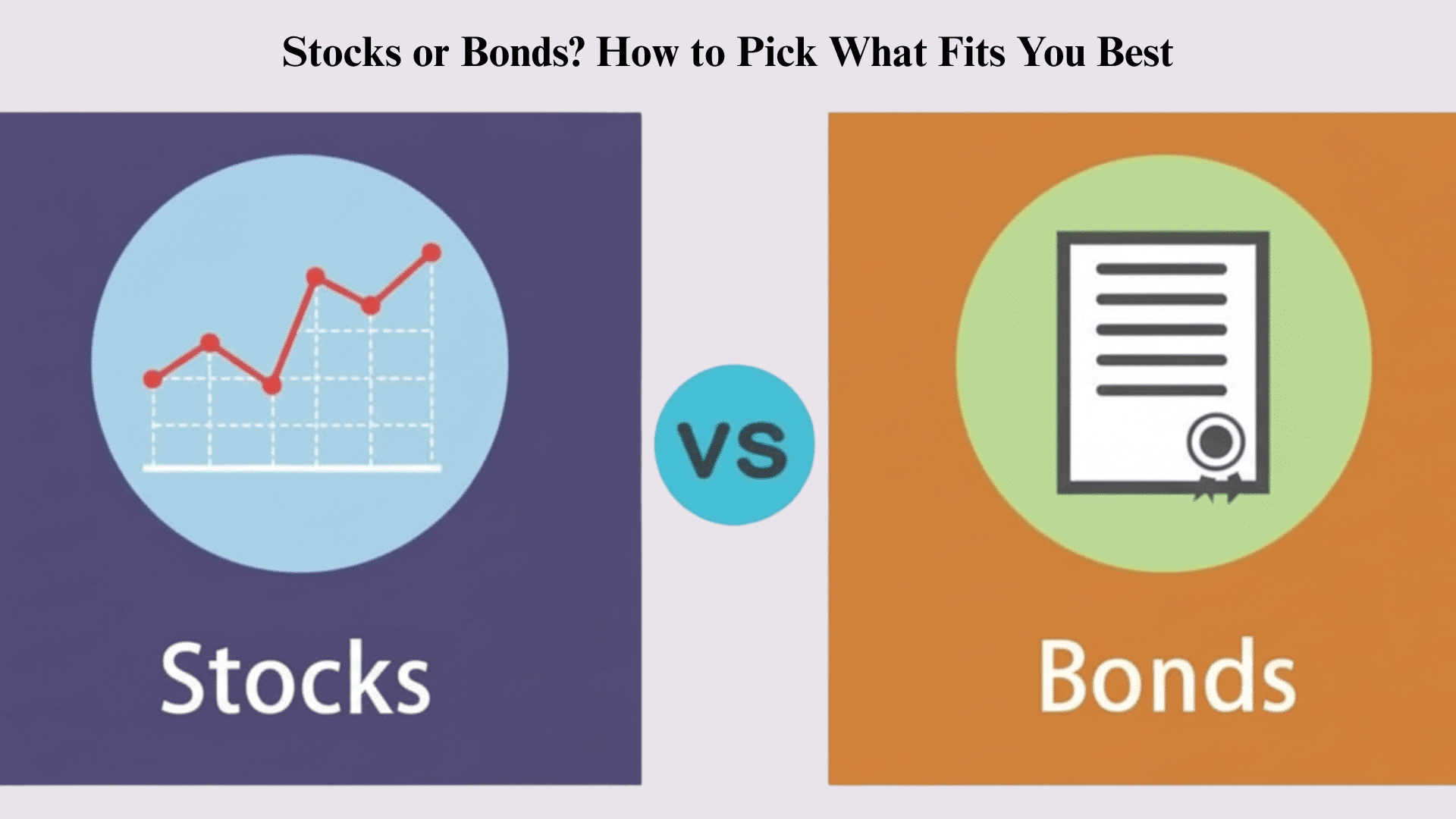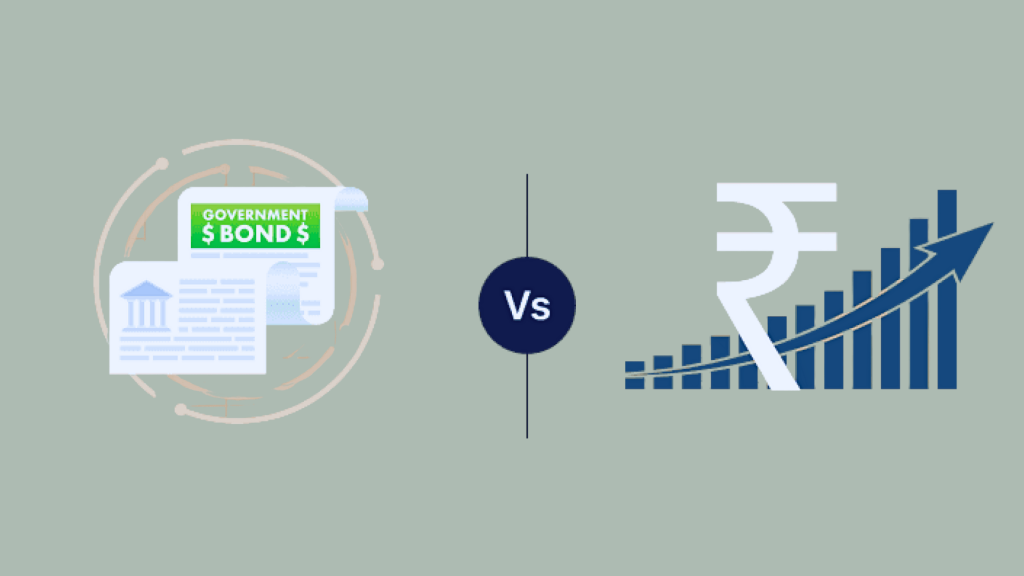Starting to learn about investing can feel like walking into a new world. You hear about stocks and bonds all the time, but understanding how they actually work requires some clarity.
Once you understand the difference between stocks and bonds, the whole idea of investing starts to make more sense. Each one helps your money in its own way; stocks focus on growth, while bonds bring steadiness.
In this post, I’ll explain what makes them different, how they fit together, and how you can use both to build a portfolio that matches your goals and comfort level.
What are Stocks?


A stock represents a piece of ownership in a company. When you buy stocks, you become a shareholder with a claim on profits and assets.
Your returns come from the company’s growth and success. Stocks trade on exchanges like the NYSE or the Nasdaq. They can be held for as long as you want.
The value goes up or down based on company performance and market conditions. This makes stocks a key tool for building wealth over time.
Characteristics of Stocks
Now that you know what stocks represent, let’s look at some of their key characteristics that show how they behave as investments.
- Ownership: You own a part of the company when you hold stocks.
- No Expiry: Stocks don’t have a maturity date; hold them as long as you wish.
- High Return Potential: Stocks can offer strong long-term gains compared to other assets.
- Volatility: Prices can swing quickly in the short term.
- Dividends: Some stocks pay regular income, but it’s not always guaranteed.
- Voting Rights: Shareholders can vote on major company decisions.
- Exchange Trading: Stocks are bought and sold on platforms like the NYSE and the Nasdaq.
How do You Earn from Stocks?
- Capital gains: Sell your stock for more than what you paid.
- Dividends: Earn regular payments from company profits.
Example: You invest $2,500 in a stock at $50 per share. The price rises to $75. Your shares are now worth $3,750, a $1,250 profit.
Types of Stocks
Stocks come in several forms, each offering different levels of risk, reward, and ownership benefits. Let’s explore the main types of stocks investors can choose from.
| Type | Description |
|---|---|
| Common Stocks | Offer ownership and voting rights; dividends not guaranteed. |
| Preferred Stocks | Provide fixed dividends and priority in bankruptcy; usually, no voting rights. |
| Growth Stocks | Companies expected to expand rapidly; pay few or no dividends. |
| Value Stocks | Established companies trading below their true value. |
| Dividend Stocks | Focus on stable income through regular payouts. |
Risks of Investing in Stocks
While stocks can build wealth over time, they carry risks you should know about. Prices can swing wildly based on news, earnings, or market mood.
Your investment can lose value quickly. Understanding these risks helps you invest smarter and avoid costly mistakes.
Key Stock Risks:
- Market Risk: Economic downturns or global events can drag down the entire market.
- Company Risk: Poor management or weak earnings can hurt your stock’s value.
- Volatility Risk: Stock prices can change rapidly and unpredictably in short periods.
- Dividend Risk: Companies may reduce or stop dividend payments without warning.
- Inflation Risk: Rising prices can eat away at your investment returns over time.
Tip: Spread your money across different sectors or use index funds to reduce these risks.
What Are Bonds?


A bond is a loan you give to a company, government, or organization. In return, they pay you interest at regular intervals. When the bond matures, you get your original money back.
Bonds are considered safer than stocks. They offer predictable income and lower risk. Investors use bonds to balance their portfolios and earn steady returns.
The issuer promises to repay you on a specific date. This makes bonds a reliable choice for income-focused investors.
Characteristics of Bonds
Once you understand what bonds are, it’s important to know the traits that define how they work and why investors use them.
- Loan Structure: Bonds represent a loan, not ownership in a company.
- Fixed Income: You receive regular interest payments on your investment.
- Maturity Date: Bonds have a set date when your principal is returned.
- Lower Volatility: Bond prices are generally more stable than stock prices.
- Priority Repayment: Bondholders get paid before shareholders if the issuer fails.
- No Voting Rights: Bonds don’t give you a say in company decisions.
How You Earn from Bonds
- Interest payments: Earn fixed income through regular coupon payments.
- Principal repayment: Get your original investment back at maturity.
Example: You buy a $1,000 bond paying 5% interest annually. You’ll earn $50 each year. At maturity, you’ll receive your $1,000 back.
Types of Bonds
Bonds come in many forms, each offering different levels of risk, return, and purpose. The type of bond you choose depends on who issues it, how long it lasts, and how much risk you’re comfortable taking. Here are the main categories investors should know:
| Type | Description |
|---|---|
| Government Bonds | Backed by national governments, very safe (e.g., U.S. Treasuries). |
| Municipal Bonds | Issued by states or cities, interest is often tax-exempt. |
| Corporate Bonds | Issued by companies; higher yields but higher risk. |
| High-Yield (Junk) Bonds | From lower-rated issuers, higher returns with greater risk. |
| Inflation-Protected Bonds (TIPS) | Adjust payments with inflation to protect purchasing power. |
Risks of Investing in Bonds
Bonds are safer than stocks, but they’re not completely risk-free. Several factors can affect your bond returns. Interest rate changes can hurt bond values.
Credit quality matters when issuers face financial trouble. Understanding these risks helps you choose the right bonds for your goals.
Key Bond Risks:
- Interest Rate Risk: When rates go up, existing bond prices drop.
- Credit Risk: The issuer may fail to pay interest or return your principal.
- Inflation Risk: Rising costs can reduce the real value of your fixed payments.
- Liquidity Risk: Some bonds are difficult to sell quickly before they mature.
- Call Risk: Issuers may repay bonds early, cutting off your future income.
Tip: Stick with high-quality bonds or use bond funds and ETFs to spread out risk.
How Interest Rates Affect Bond Prices?
Bond prices and interest rates move in opposite directions. When rates rise, bond prices fall. When rates drop, bond prices go up.
This happens because new bonds offer better returns when rates climb. Older bonds with lower rates become less attractive. Investors sell them at a discount to buy newer, higher-paying bonds.
The sensitivity of a bond’s price to rate changes is measured by duration. Bonds with longer durations are more affected by rate shifts.
Understanding this relationship helps you time your bond investments better.
What Bond Credit Ratings Mean for Investors?
Credit rating agencies evaluate how likely a bond issuer is to repay its debt. Agencies like Moody’s, S&P, and Fitch give bonds letter grades.
These ratings help investors judge risk before buying. Higher-rated bonds are safer but offer lower returns. Lower-rated bonds pay more but carry greater default risk.
Checking ratings before you invest protects your money and guides smarter decisions.
Bond Rating Categories:
- AAA–BBB: Investment-grade bonds with low risk of default.
- BB or lower: High-yield or “junk” bonds with higher returns but greater risk.
Difference Between Stocks and Bonds


Understanding how bonds vs stocks differ helps you decide how much of each to include in your portfolio.
The table below shows the main distinctions in how they work, the risks they carry, and what kind of returns you can expect.
| Feature | Stocks | Bonds |
|---|---|---|
| What You Own | A share of ownership in a company | A loan to a company or government |
| Purpose | Growth and wealth building | Income and stability |
| Risk Level | Higher: prices can change quickly | Lower: steady income but smaller gains |
| Returns | Higher long-term potential | Lower but more predictable |
| Income Type | Dividends (not guaranteed) | Fixed interest payments |
| Time Frame | No maturity date | Fixed term until maturity |
| Claim Priority | Last, if the company fails | First to be repaid in default |
| Liquidity | Easy to buy and sell on exchanges | It can take longer to sell, though bond funds are liquid |
| Volatility | Higher: values move with the market | Lower: less sensitive to daily news |
Stocks drive long-term growth, while bonds add balance and steady income. Most investors hold both stocks to grow wealth and bonds to help protect it when markets move up and down.
Taxes: Stocks vs. Bonds
Taxes work differently for stocks and bonds, and knowing this can save you money. Stock dividends are taxed as income, while qualified dividends are taxed at lower rates.
You pay capital gains tax when you sell stocks for a profit. Bond interest is usually taxed as regular income at your standard rate.
However, municipal bonds often come with federal tax breaks. Treasury bonds skip state and local taxes. Understanding these tax rules helps you keep more of your returns and plan better.
| Investment Type | Income Type | Tax Treatment |
|---|---|---|
| Stocks | Dividends | Taxed as ordinary income or at qualified dividend rates |
| Capital Gains | Taxed when you sell at a profit | |
| Bonds | Interest Income | Taxed as ordinary income |
| Municipal Bonds | Often exempt from federal taxes | |
| Treasuries | Exempt from state and local taxes |
How do Stocks and Bonds Work Together?
You don’t have to pick just one. The strongest portfolios usually include both stocks and bonds.
- Stocks help your money grow faster over time.
- Bonds help keep things steady when the market gets bumpy.
When stock prices drop, bond values often hold steady, or even rise a little. That balance helps protect your total returns and keeps your portfolio from losing too much during market downturns.
Balancing Risk and Return
Finding the right mix of stocks and bonds depends on your goals and comfort level.
Here’s a simple way to think about it:
- Conservative investors: 70% bonds, 30% stocks, focus on safety and income.
- Moderate investors: 50% bonds, 50% stocks, aim for steady growth with moderate risk.
- Aggressive investors: 80% stocks, 20% bonds, focus on growth, and accept more ups and downs.
You can adjust your mix as your life changes. Most people hold more stocks when they’re younger and gradually add more bonds as they near retirement.
This mix of investments is called asset allocation, and it’s one of the most important ways to balance risk and reward in investing.
How to Choose Between Stocks and Bonds


Choosing between stocks and bonds comes down to three main things: your goals, your comfort with risk, and what’s happening in the market.
1. Based on Your Goals
If your goal is long-term growth, like saving for retirement, you’ll likely want to hold more stocks. Stocks give your money the best chance to grow over time, even though prices may swing up and down.
If your goal is short-term stability, such as saving for a home or protecting money close to retirement, you’ll want more bonds. Bonds provide steady income and help reduce sudden drops in value.
2. Based on Risk Tolerance
Think about how you feel when the market moves.
- If you don’t like seeing your account drop during market dips, keep a larger share in bonds. They’ll make your portfolio more stable.
- If you can handle short-term losses for the chance at higher growth, lean more toward stocks.
Knowing your comfort level helps you stay calm and avoid emotional decisions when markets get rough.
3. Based on Market Conditions
Sometimes, what’s happening in the economy can guide your choices.
- When interest rates rise, new bonds pay more, which makes them more attractive.
- When the economy grows strongly, stocks often perform better because company profits increase.
It’s not about guessing the market; it’s about understanding what environment you’re in and adjusting carefully if needed.
In the end, your ideal mix will depend on your time frame, your goals, and how much risk feels right to you.
Start with a balanced approach, review it once a year, and make small changes as your situation or priorities shift.
Key Investing Pitfalls and How to Fix Them
Avoid these simple but costly investing mistakes:
| Mistake | Why It’s a Problem | Better Approach |
|---|---|---|
| Putting all your money in one type | You miss either growth or stability. | Hold both stocks and bonds for balance. |
| Ignoring your comfort with risk | You may panic and sell during drops. | Pick a mix that fits your risk level. |
| Trying to time the market | Guessing often means missing gains. | Invest regularly instead of timing. |
| Skipping rebalancing | Your mix drifts off track over time. | Rebalance yearly to stay aligned. |
Small adjustments and steady habits make a bigger difference than big, risky moves.
Wrap Up
Understanding the difference between stocks and bonds gives you more control over how you grow and protect your money. Stocks help build long-term growth, while bonds keep things steady when the market moves around.
I like to think of it as teamwork, one drives progress, the other keeps balance. Finding your mix doesn’t have to be complicated; it just needs to match your comfort level and goals.
Take a little time to look at your portfolio, make small adjustments, and stay consistent. Over time, that’s what keeps your money working for you.
If you found this helpful, check out more posts for simple investing ideas and tips.

